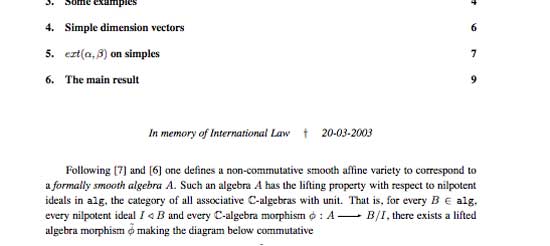Let us
take a hopeless problem, motivate why something like non-commutative
algebraic geometry might help to solve it, and verify whether this
promise is kept.
Suppose we want to know all solutions in invertible
matrices to the braid relation (or Yang-Baxter equation)

All such solutions (for varying size of matrices)
form an additive Abelian category  , so a big step forward would be to know all its
, so a big step forward would be to know all its
simple solutions (that is, those whose matrices cannot be brought in
upper triangular block form). A literature check shows that even this
task is far too ambitious. The best result to date is the classification
due to Imre Tuba and
Hans Wenzl of simple solutions of which the matrix size is at most
5.
For fixed matrix size n, finding solutions in  is the same as solving a system of
is the same as solving a system of  cubic
cubic
polynomial relations in 
unknowns, which quickly becomes a daunting task. Algebraic geometry
tells us that all solutions, say  form an affine closed subvariety of
form an affine closed subvariety of  -dimensional affine space. If we assume that
-dimensional affine space. If we assume that  is a smooth variety (that is, a manifold) and
is a smooth variety (that is, a manifold) and
if we know one solution explicitly, then we can use the tangent space in
this point to linearize the problem and to get at all solutions in a
neighborhood.
So, here is an idea : assume that  itself would be a non-commutative manifold, then
itself would be a non-commutative manifold, then
we might linearize our problem by considering tangent spaces and obtain
new solutions out of already known ones. But, what is a non-commutative
manifold? Well, by the above we at least require that for all integers n
the commutative variety  is a commutative manifold.
is a commutative manifold.
But, there
is still some redundancy in our problem : if  is a
is a
solution, then so is any conjugated pair  where
where  is a basechange matrix. In categorical terms, we are only
is a basechange matrix. In categorical terms, we are only
interested in isomorphism classes of solutions. Again, if we fix the
size n of matrix-solutions, we consider the affine variety  as a variety with a
as a variety with a  -action
-action
and we like to classify the orbits of simple solutions. If  is a manifold then the theory of Luna slices
is a manifold then the theory of Luna slices
provides a method, both to linearize the problem as well as to reduce
its complexity. Instead of the tangent space we consider the normal
space N to the  -orbit
-orbit
(in a suitable solution). On this affine space, the stabilizer subgroup
 acts and there is a natural one-to-one
acts and there is a natural one-to-one
correspondence between  -orbits
-orbits
in  and
and  -orbits in the normal space N (at least in a
-orbits in the normal space N (at least in a
neighborhood of the solution).
So, here is a refinement of the
idea : we would like to view  as a non-commutative manifold with a group action
as a non-commutative manifold with a group action
given by the notion of isomorphism. Then, in order to get new isoclasses
of solutions from a constructed one we want to reduce the size of our
problem by considering a linearization (the normal space to the orbit)
and on it an easier isomorphism problem.
However, we immediately
encounter a problem : calculating ranks of Jacobians we discover that
already  is not a smooth variety so there is not a
is not a smooth variety so there is not a
chance in the world that  might be a useful non-commutative manifold.
might be a useful non-commutative manifold.
Still, if  is a
is a
solution to the braid relation, then the matrix 
commutes with both X and Y.
If  is a
is a
simple solution, this means that after performing a basechange,  becomes a scalar matrix, say
becomes a scalar matrix, say  . But then,
. But then,  is a solution to
is a solution to

and all such solutions form a
non-commutative closed subvariety, say  of
of  and if we know all (isomorphism classes of)
and if we know all (isomorphism classes of)
simple solutions in  we have solved our problem as we just have to
we have solved our problem as we just have to
bring in the additional scalar  .
.
Here we strike gold :  is indeed a non-commutative manifold. This can
is indeed a non-commutative manifold. This can
be seen by identifying 
with one of the most famous discrete infinite groups in mathematics :
the modular group  . The modular group acts by Mobius
. The modular group acts by Mobius
transformations on the upper half plane and this action can be used to
write  as the free group product
as the free group product  . Finally, using
. Finally, using
classical representation theory of finite groups it follows that indeed
all  are commutative manifolds (possibly having
are commutative manifolds (possibly having
many connected components)! So, let us try to linearize this problem by
looking at its non-commutative tangent space, if we can figure out what
this might be.
Here is another idea (or rather a dogma) : in the
world of non-commutative manifolds, the role of affine spaces is played
by  the representations of finite quivers Q. A quiver
the representations of finite quivers Q. A quiver
is just on oriented graph and a representation of it assigns to each
vertex a finite dimensional vector space and to each arrow a linear map
between the vertex-vector spaces. The notion of isomorphism in  is of course induced by base change actions in all
is of course induced by base change actions in all
of these vertex-vector spaces. (to be continued)
